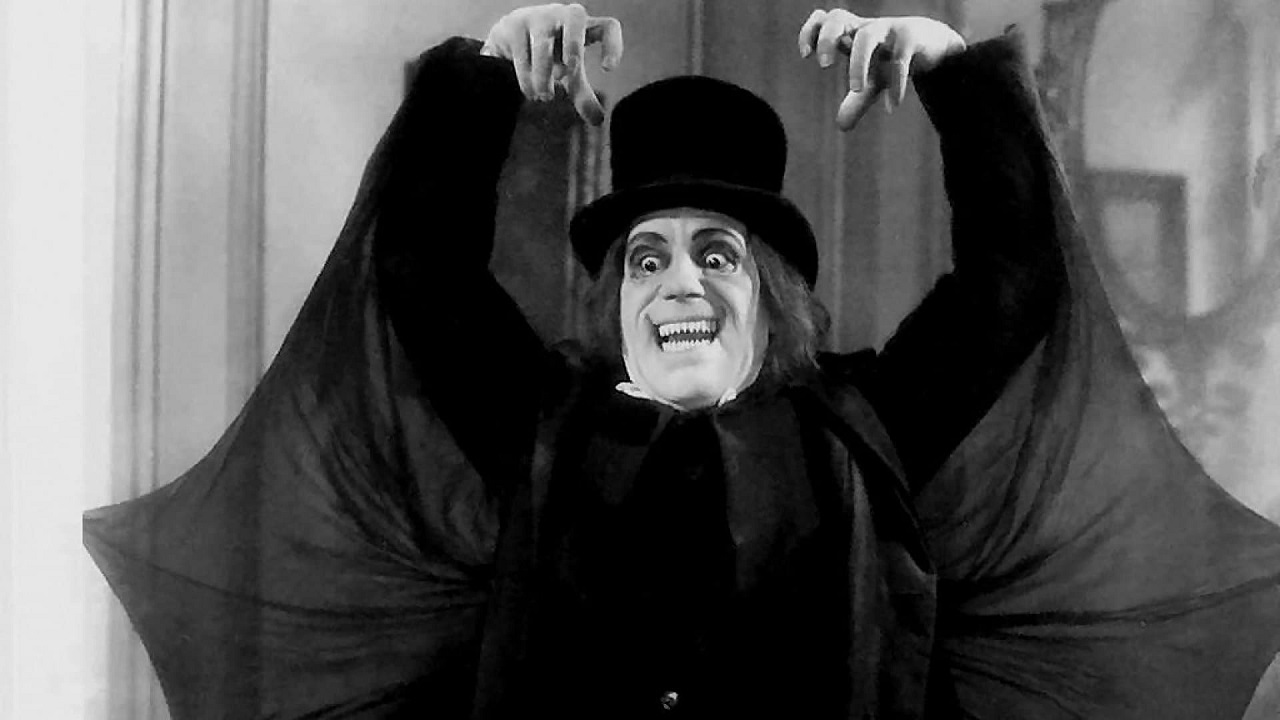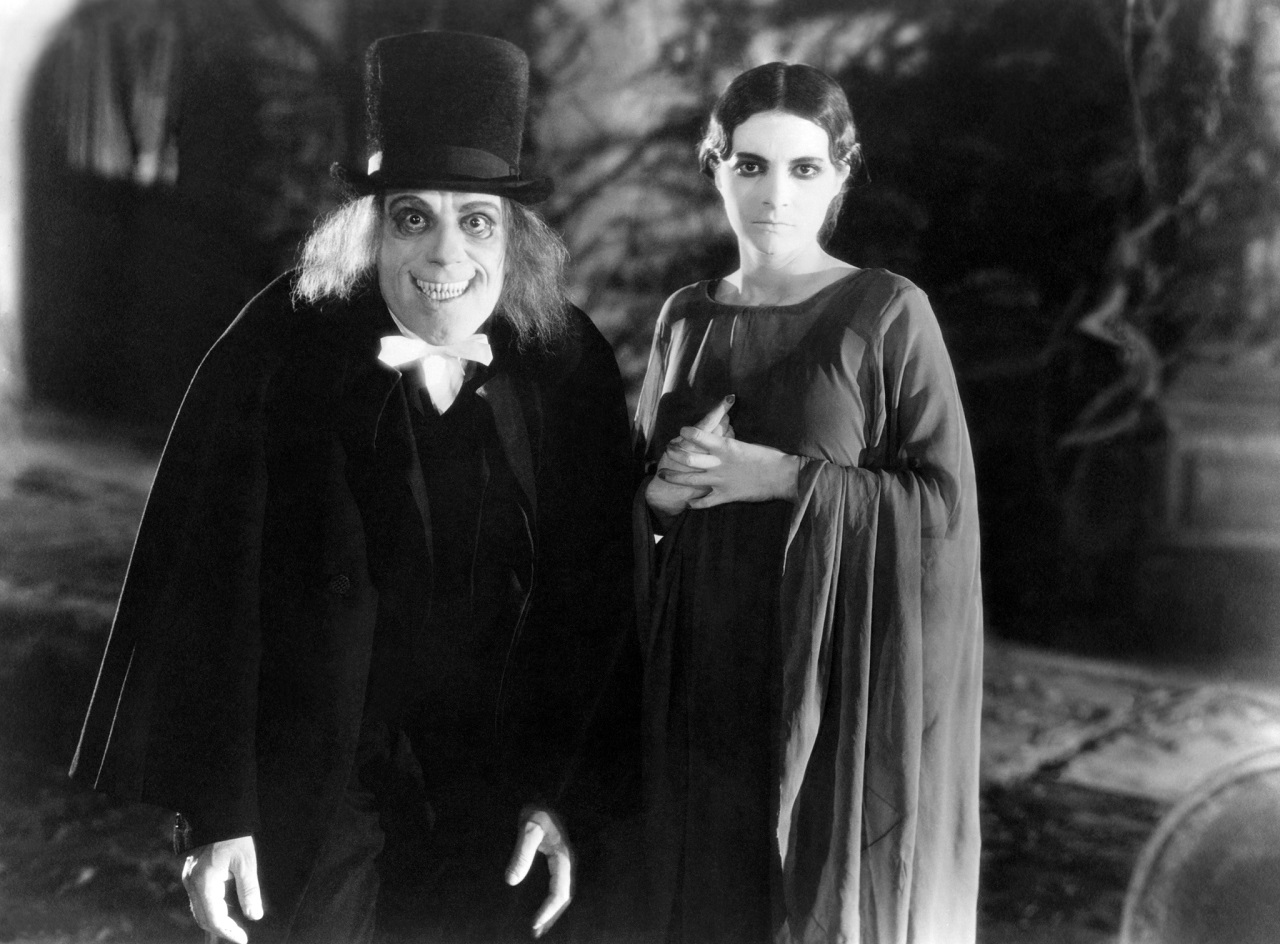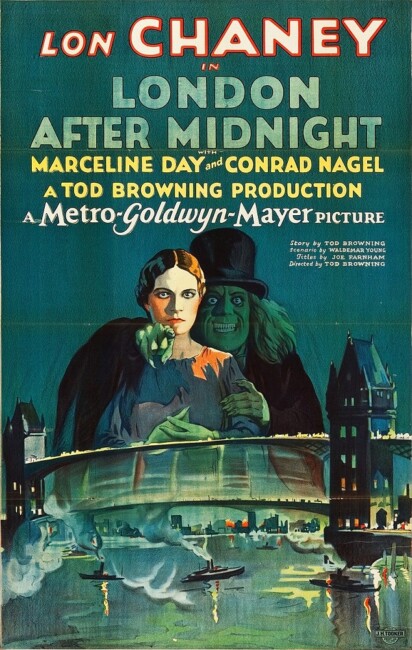Crew
Director – Tod Browning, Screenplay – Waldemar Young, Based on the Short Story The Hypnotist by Tod Browning, Photography (b&w) – Merritt B. Gerstad, Production Design – Cedric Gibbons & A. Arnold Gillespie. Production Company – MGM.
Cast
Lon Chaney (Professor Edward Burke), Henry B. Walthall (Sir James Hamlin), Conrad Nagel (Arthur Hibbs), Marceline Day (Lucille Balfour), Polly Moran (Miss Smithson), Claude King (Roger Balfour), Edna Tichenor (Luna)
Plot
Police inspector Edward Burke investigates the death of Roger Balfour who has been found shot in his country home and a suicide note left. Five years later, the neighbouring Hamlin household becomes fearful as the Balfour house is taken over by two sinister figures that are believed to be vampires. Roger’s grave is found violated and his body missing. He is later seen alive inside the Balfour mansion. As people become scared, Inspector Burke uses hypnosis to draw out Roger’s murderer.
London After Midnight is one of the famous lost films of the great silent screen actor Lon Chaney [Sr]. Lon Chaney was an incredible actor who would go to extraordinary lengths for a role, including strapping his own legs up to play a legless cripple in The Penalty (1920), wearing a heavy harness on his back to become The Hunchback of Notre Dame (1923) and training to use his feet as hands to portray an armless knife-thrower in The Unknown (1927). London After Midnight was one of ten collaborations that Lon Chaney made with director Tod Browning.
London After Midnight was believed lost forever after the only remaining print was destroyed in a fire at the MGM archives in 1966. All that was left was the fading memories of those who had seen the original, some stills and Tod Browning’s sound remake Mark of the Vampire (1935), which offered an indication of what fans might have seen.
In 2002, the Turner Classic Movie channel conducted a mammoth and painstaking effort at piecing the original back together, commissioning Rick Schmidlin, who had supervised similar reconstruction projects of Intolerance (1916), Greed (1925) and Orson Welles’s Touch of Evil (1958). The result premiered on TCM on Halloween night of 2003 to mark the original’s 75th anniversary. With no surviving footage, all that remained at Rick Schmidlin’s disposal was the original script and around 200 stills. The stills have been dramatically blown up and moved around in a dramatic fashion, with a score by Robert Israel added over the top and both action and dialogue relayed through intertitle cards.

The restoration gets full marks for effort but as a film the results are at once both fascinating and disappointing. This type of archival archaeology offers up an extraordinary glimpse, as much as it might remainingly be possible, to see what this lost classic would have been like. There are nevertheless some things that you cannot tell from the restoration. Limited to only moving around surviving stills, it is impossible to see what kind of atmosphere that Tod Browning might have invested the film itself with. It is also hard to work out which parts are genuine intertitle cards and which are standing in for scene descriptions.
Despite such limitations, the intensity of Lon Chaney’s performance(s) manages to stand out. As the vampire in stovepipe hat, his eyes made to unnaturally bulge out and his teeth frozen in a Joker-like rictus grin using wires, Chaney leers from the screen with a vile, crepuscular intensity. In the substantially larger second role of Inspector Burke, with his hair slicked back and hawkish looks made prominent, Chaney projects a commanding certainty. The performance would have been fascinating to see in actuality – as such, Chaney still manages to intimidate and dominate the show from the frozen screen.
Where London After Midnight disappoints is surely in the build-up of its reputation. Unavailability of the genuine article to compare to and the vagaries of memory tend to amplify status of lost films and one suspects the original was not that good a film. Even relayed by stills here and only at 45 minutes in length, it seems dull and talky. The vampire’s appearances are disappointingly limited to only a couple of scenes and Tod Browning seems more interested in the whodunnit aspect than he does the horror.
As a whodunnit however, the film is done in by a particularly contrived and unbelievable twist ending that reveals all the hauntings to have been a charade set up to lure out a guilty murderer. As with many films from the era – The Cabinet of Dr Caligari (1919), The Cat and the Canary (1927), Seven Footprints to Satan (1929), The Beast with Five Fingers (1946) – such manifestations of the supernatural were routinely revealed with ludicrous contrivation to be mundane in nature as though Hollywood were afraid of genuine manifestations of the supernatural in some way.

Tod Browning’s sound remake Mark of the Vampire has long been regarded as an inferior remake. This revival of London After Midnight may now show that the original’s unavailability has amplified its stature in comparison and that it is not the lost masterpiece it has been seen as. Its reputation is certainly overrated and by comparison Mark of the Vampire is simply a remake, no more, no less. Mark of the Vampire is certainly the better budgeted and the more technically proficient. In Mark of the Vampire, Tod Browning seems to spend more time on atmosphere but both films are still infected by the same inherently implausible and contrived twist ending.
Of course, the big difference between Mark of the Vampire and London After Midnight is that in the remake Lon Chaney’s roles are spread between two actors – with Bela Lugosi as the vampire and Lionel Barrymore as the police inspector. Lon Chaney’s death in 1930 was of great loss to Tod Browning who lost his greatest collaborator – he tried to find replacements in the likes of Bela Lugosi and Lionel Barrymore in various films in the sound era but without avail, and neither of the roles in the remake has the intensity that Lon Chaney brings to London After Midnight even in stills. The one plus about Mark of the Vampire is Carroll Borland’s Luna. Edna Tichenor’s Bat Girl here is merely a waif in black eyeliner and ill-fitting wings – in Mark of the Vampire, Borland brought a genuine otherworldly intensity.
In a trivia note, a two-part episode of the crime tv series Whitechapel (2009-13) was built around the considerably fictionalised legend of London After Midnight, claiming that the reason for its obscurity was that it had driven everyone who saw it insane and featuring a killer who had the last remaining copy.
Tod Browning other genre films are:– The Unknown (1027), a perverse love story featuring Lon Chaney as an armless knife thrower; the Bela Lugosi Dracula (1931); the classic Freaks (1932); and The Devil-Doll (1936). Also of interest is the documentary Lon Chaney: A Thousand Faces (2000) concerning the fascinating career of Lon Chaney.


